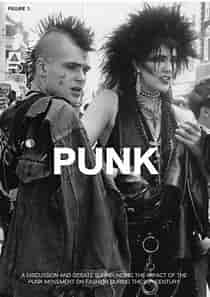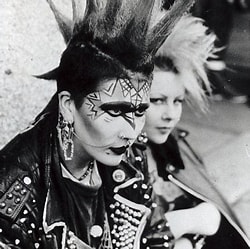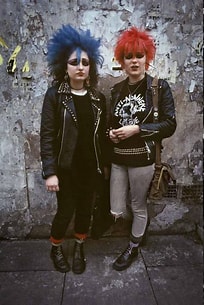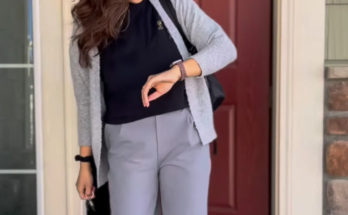The Punk Revolution
Introduction
The punk movement, a vibrant explosion of music, art, and fashion, emerged in the 1970s as a powerful response to societal norms and cultural expectations. With its roots deeply embedded in rebellion, the punk aesthetic has become synonymous with defiance and individuality. But what is it about punk fashion that continues to resonate today? In this article, we will explore the origins, evolution, and enduring impact of punk style as a form of rebellion.
The Birth of Punk Fashion
A Response to Conformity
Punk fashion began as a reaction against the mainstream culture of the 1970s, characterized by its excess and conformity. In cities like New York and London, a disillusioned youth sought to express their frustrations through a raw and unfiltered style. This was not just about clothing; it was a statement against the status quo, a visual rebellion that challenged societal norms.

Key Influencers: Vivienne Westwood and Malcolm McLaren
Vivienne Westwood and Malcolm McLaren played pivotal roles in shaping punk fashion. Their boutique “Sex” in London became a hub for punk culture, showcasing designs that were provocative and unapologetic. Westwood’s creations, such as the infamous “Destroy” T-shirt, transformed clothing into a canvas for dissent, embodying the spirit of rebellion that defined the movement.
The Aesthetic of Punk
DIY Ethos: Creating Your Own Style
At the heart of punk fashion is the Do It Yourself (DIY) ethos. This philosophy encourages individuals to create their own style rather than conforming to mass-produced trends. Punks often customized their clothing with safety pins, patches, and bold graphics, turning everyday items into unique expressions of identity.
Iconic Elements of Punk Style
Punk fashion is characterized by several iconic elements:
- Leather Jackets: A staple of the punk wardrobe, often adorned with studs and patches.
- Ripped Clothing: Torn fabrics symbolize rebellion against consumerism.
- Bold Hair Colors: Brightly colored hair and spiked hairstyles challenge traditional beauty standards.
- Combat Boots: Practical yet edgy footwear that complements the punk aesthetic.
These elements combine to create a look that is both striking and deeply meaningful.

The Political Undertones of Punk Fashion
Fashion as Protest
Punk fashion is not just about aesthetics; it serves as a powerful form of protest. Clothing becomes a weapon against societal injustices, allowing individuals to express their dissent without uttering a word. The use of provocative imagery and slogans on clothing amplifies this message, making punk attire a visual language of resistance.
Gender and Identity in Punk
Punk culture has also challenged traditional gender norms. Crossdressing and androgyny are prevalent within the movement, allowing individuals to express their identities freely. This rejection of binary gender roles has paved the way for greater acceptance of diverse identities within fashion.
The Evolution of Punk Fashion
From Underground to Mainstream
While punk began as an underground movement, its influence has permeated mainstream culture over the decades. Designers have drawn inspiration from punk aesthetics, incorporating elements into high fashion collections. However, this commercialization has sparked debates about authenticity within the movement.
Punk’s Resurgence in Contemporary Fashion
In recent years, there has been a resurgence of interest in punk fashion. Designers are revisiting the rebellious spirit of punk while infusing it with modern sensibilities. This revival highlights how punk continues to inspire new generations seeking to challenge societal norms through style.

The Cultural Impact of Punk Fashion
Music and Fashion: An Unbreakable Bond
Punk music and fashion are intrinsically linked. Bands like the Sex Pistols and The Clash not only defined the sound of an era but also influenced how fans dressed. Their performances were not just concerts; they were acts of rebellion that showcased their distinctive styles.
Punk as a Global Movement
The impact of punk fashion extends beyond Western cultures. In various parts of the world, punk has become a symbol of resistance against oppressive regimes. For instance, in Eastern Europe during the Soviet era, punk music and fashion provided an outlet for self-expression amidst strict government control.
The Criticism Surrounding Punk Fashion
Misunderstandings About Artistic Intent
Critics often argue that fashion should remain utilitarian rather than being elevated to an art form. They dismiss punk fashion’s artistic expressions as mere attempts to provoke or shock. However, proponents argue that punk style embodies complex messages about identity and societal critique.
The Risk of Commercialization
As punk elements have entered mainstream fashion, there is concern about losing the movement’s original spirit. When designers commodify punk aesthetics without understanding their significance, it risks diluting the message of rebellion that underpins them.
Read This: The Evolution of Fashion Trends: A Look Back at the Last Decade
Conclusion
The punk revolution remains a powerful testament to how style can serve as a vehicle for rebellion and self-expression. From its raw beginnings in the 1970s to its ongoing influence today, punk fashion challenges us to question societal norms and embrace individuality. As we continue to navigate an ever-changing cultural landscape, let us remember that true rebellion lies in our ability to express ourselves authentically through our choices—whether in music or in what we wear.
FAQs
1. What defines punk fashion?
Punk fashion is characterized by its DIY ethos, use of ripped clothing, leather jackets, bold hair colors, and combat boots—all symbols of rebellion against conformity.
2. Who were key figures in the development of punk fashion?
Vivienne Westwood and Malcolm McLaren were instrumental in shaping punk fashion through their designs at their boutique “Sex,” which became central to the movement.
3. How does punk fashion serve as protest?
Punk attire often features provocative imagery and slogans that challenge societal norms and injustices, making clothing a powerful medium for dissent.
4. Is punk fashion still relevant today?
Yes! Punk fashion continues to inspire contemporary designers and remains a symbol of individuality and rebellion against mainstream culture.
5. How did gender roles evolve within punk culture?
Punk culture has challenged traditional gender norms by embracing crossdressing and androgyny, allowing individuals to express their identities freely without conforming to societal expectations.
Meta Description
Explore how punk revolutionized style as a form of rebellion against societal norms through its DIY ethos, iconic elements, and cultural impact from the 1970s to today.


